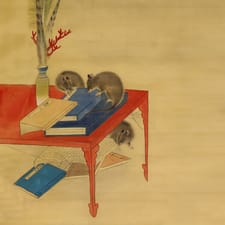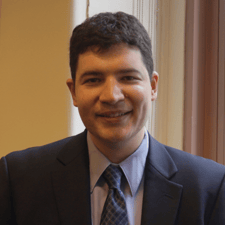Cowering, Timorous Beasties
What the rats taught Edward Tolman about academic freedom.
By Ben Lovett
“Rats on a Scholar’s Desk” by Nagasawa Rosetsu, 1790. The Metropolitan Museum of Art, New York, public domain.
In June 1954, Edward Tolman was in a reflective mood. The Berkeley psychologist was a guest speaker at a McGill University convocation and chose as the title of his address, “Freedom and the Cognitive Need.” In it, he connected his long-earned disciplinary expertise in animal learning to a more recent interest: the freedom of individual faculty to maintain and express their own beliefs.
Throughout his research career, Tolman had championed unpopular viewpoints. He worked in an era when psychology was dominated by extreme forms of behaviorism, an approach that viewed organisms essentially as blank slates and denied the value of studying anything other than observable stimuli and responses. Tolman used the research tools that his peers did — observing rats as they made their way through mazes — but he repeatedly found results that challenged behaviorist dogmas.
Against the blank slate view, Tolman found that maze-learning ability was genetically influenced; breeding “maze-bright” rats together made a new generation of rats that were especially fast learners, whereas breeding “maze-dull” rats together did the reverse. He also experimented with increasingly complex mazes, finding that his most experienced rats could creatively find their way around new barriers and altered paths — skills that only made sense if the rats had acquired a “cognitive map” of the mazes.
Although he was advancing minority viewpoints, Tolman had such compelling data that he was well-published in top peer-reviewed journals and became an eminent figure in the field. Even while he was still alive, one textbook on learning theory had already devoted an entire chapter to Tolman’s ideas. He was also a beloved mentor, in part because he let students develop their own ideas, even if they differed significantly from his. One of Tolman’s Berkeley Ph.D. students, Henry Gleitman, recalled Tolman finding out that Gleitman had been advancing ideas very similar to those of Tolman’s intellectual nemesis, Clark Hull. Tolman was surprised but accepting: “Gleitman, you son of a bitch, I hear you are becoming a Hullian! So ok. Just be a good Hullian!”
He noted, playfully, that professors are really not so different from rats.
It was after several decades of highly respected research work that Tolman found himself at the center of a political controversy. A committed pacifist raised in Quaker traditions, Tolman never sought out conflict, but this time it came to him. In 1949, in the thick of the McCarthy Era, the University of California asked faculty members to sign an oath confirming that they were not members of any organization that believes in “the overthrow of the United States government by force or violence.” The University initially had the Communist Party in mind, but extended the requirement more broadly. At that time, even tenured faculty members received formal annual contracts, and that year, only those who signed the new oath received contracts.
Tolman objected to the oath, not because he was a member of any subversive group but because he worried that if a professor was a member of a group that had other members with subversive beliefs, the beliefs might be attributed to the group, and the professor would be found in violation of the oath. More basically, he objected “as a psychologist” to the claim that a group can “believe” things. In sum, he said, the oath was “neither good psychology nor good civil rights.”
After expressing this at the faculty senate, Tolman became the leader of a small group of professors known as the “non-signers.” And, in the summer of 1950, when the University Board of Regents voted to fire all non-signers, Tolman became the lead plaintiff in a lawsuit brought by 20 professors.
Tolman and his colleagues won in court in 1951, and the opinion is still worth reading, with the court acknowledging that the oath was “undoubtedly motivated by a desire to protect the University from the influences of subversive elements,” but noting that “equal to the danger of subversion from without by means of force and violence is the danger of subversion from within by the gradual whittling away and the resulting disintegration of the very pillars of our freedom.”
So in 1954, while visiting McGill near the end of his career, Tolman could reflect on both his long experience with animal learning and his recent, more intense experience with academic freedom disputes. He started by reviewing some principles of learning. Tolman pointed out that although the hungriest rats are the ones most in need of food, they are actually not as good at finding food in a maze as less desperate rats. Moreover, intense physical needs such as extreme hunger tend to interfere with cognitive needs such as curiosity.
He then noted, playfully, that professors are really not so different from rats. If a professor is afraid that saying the wrong thing could lead to getting fired (thus risking hunger), the quality of the professor’s work will decline:
"He will not only write a poorer speech, but he will also become a poorer, more timid teacher, a blind type of research worker, and a neurotic committeeman. He will tend to fall down in all his activities. What I am saying is, in short, that any teacher, if he is to be what our liberal society “says” it wants him to be — namely, an open-minded, objective proponent of, and searcher for, truth — must then not be subjected to too strong economic fears or too strong social attacks. And this, of course, is why we educators proclaim aloud the principles of Academic Freedom and Academic Tenure….We teachers will not do our jobs well whenever we are made into wee, cowering, timorous beasties."
Seventy years later, many professors will likely nod sadly at Tolman’s words. There are still politicians who want to ensure that professors are sufficiently patriotic. Worse, many professors also now face illiberal colleagues and administrative bureaucracies that interrogate their teaching and stymie their research for a host of other reasons. But we can light our own corners of academia, and Tolman can inspire this as well. He actually didn’t complain too much, and neither should we. Tolman spent much more time just doing the work that he enjoyed. In 1959, the year of his death, Tolman published the final statement of his ideas on psychology, and concluded that, whether or not his theory of learning held up over time, “In the end, the only sure criterion is to have fun. And I have had fun.”
